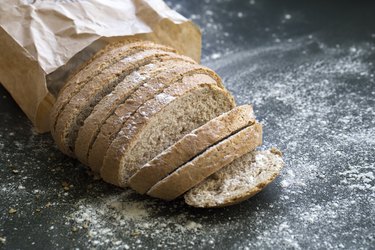
You're probably aware that not all bread is created equal. If you find the labels on white or wheat bread vs. whole grain bread confusing, you're not alone. There are nutritional and health differences between different types of wheat bread, so it's important to know what you're purchasing.
As a rule, you'll find more fiber, vitamins, minerals, and other health-promoting compounds in whole-wheat bread vs. white bread. However, it's important to know that not all wheat bread is whole-wheat or whole-grain bread.
Video of the Day
Video of the Day
Wheat Bread vs. Whole Grain
Wheat is one of many different types of grains that can be used to bake bread. However, wheat comes in many forms, depending on the degree that it's processed. In most cases, the word "wheat" on an ingredients label, means white or refined wheat.
Some labels will say "whole wheat" or "whole grain," which have a different meaning. According to the Whole Grains Council, the word "whole" on a bread, cereal or pasta label indicates that the grain used has not been refined, or stripped of its outer layers.
In other words, it contains all three parts of the grain (the bran, germ, and endosperm) in the same proportions as when it was growing in the fields. It's confusing, but the most important thing to look for when buying bread, or any grain-based food for that matter, is the word "whole." Wheat bread vs. white bread is not necessarily a healthier option, but when you're comparing wheat bread vs. whole grain bread, the word "whole" means it's a healthier option.
The Nutritional Differences
When comparing wheat bread vs. whole grain bread, a check of the nutrition facts label will generally show that whole grain or whole-wheat bread has more fiber and often more fat and protein. That's because the outer bran part of a wheat grain is where you'll find healthy fats and fiber and the inner germ has more protein. Using the whole grain also results in more vitamins iron and other health-promoting antioxidants.
Read more: 10 Myths About Grains – Totally Busted
The USDA lists one regular slice of whole-wheat bread as having 91 calories, 4 grams of protein, 1 gram of fat, 15 grams of carbohydrates and 2 grams of fiber. Regular white wheat bread on the other hand, has 75 calories, 2 grams of protein, less than 1 gram of fat, 14 grams of carbs and less than 1 gram of fiber per slice.
Health Benefits of Whole Grains
Much research has been done on the health benefits of whole grains, including whole-wheat bread vs. white bread. Besides the fact that refined grains are lower in fiber and many important nutrients, they also tend to have a higher glycemic index. High glycemic index foods are associated with an increased risk of metabolic diseases, especially insulin resistance and diabetes.
On the other hand, a review article published in the October 2016 issue of the Journal of Nutritional & Food Science found significant evidence that diets higher in whole grains reduce the risk of both diabetes and heart disease.
Switching from white bread to whole grain bread might also help you to live a longer and happier life, while aging better. An analysis published in June 2019 in the journal Nutrients looked at 3,349 participants who were older than 50. Researchers found that those who eat more whole grains are healthier overall. They tend to have fewer incidences of chronic diseases, healthier weights, less depression and more fulfilling family and social lives.
Read more: List of Foods Good for Pre-Diabetics
Other Grains to Consider
Whole-wheat bread is one way to get the benefits of whole grains, but if you're not a bread eater, there are other options. Choosing whole-wheat vs. white pasta is an easy swap that comes with health benefits. In the past, the taste and texture of whole-wheat pasta were an issue for many.
However, whole-wheat pasta has come a long way, so it's worth a try. Chances are, any taste or texture difference between whole-wheat and white pasta is hardly noticeable. Whole grains like oatmeal, farro and brown rice, are other great options to add to your meals. And if you're gluten-free, try millet, amaranth or sorghum, all of which are gluten-free whole grains.
- Whole Grains Council: “What’s a Whole Grain? A Refined Grain?”
- USDA FoodData Central: “Bread, Whole Wheat”
- USDA FoodData Central: “Bread, White”
- Journal of Nutritional Health & Food Science: “Whole Grains in Amelioration of Metabolic Derangements”
- Nutrients: “The Association Between Whole Grain Products Consumption and Successful Aging: A Combined Analysis of MEDIS and ATTICA Epidemiological Studies”